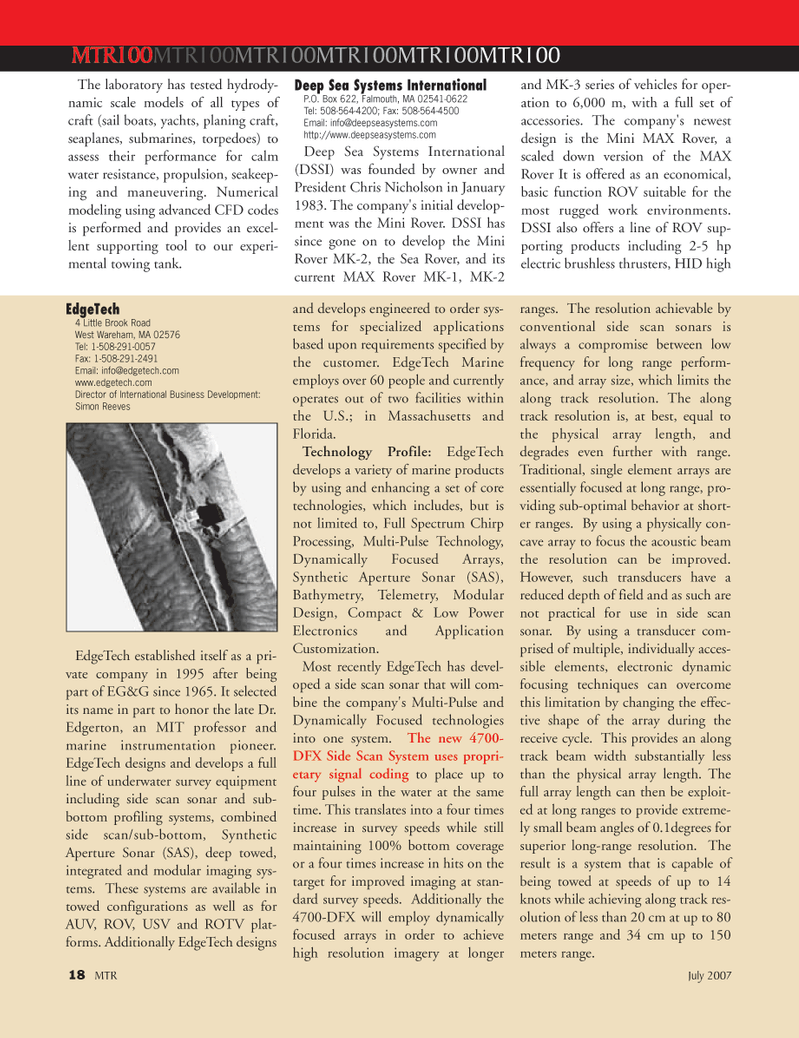
Page 18: of Marine Technology Magazine (July 2007)
The MTR 100
Read this page in Pdf, Flash or Html5 edition of July 2007 Marine Technology Magazine
18 MTR July 2007
The laboratory has tested hydrody- namic scale models of all types of craft (sail boats, yachts, planing craft, seaplanes, submarines, torpedoes) to assess their performance for calm water resistance, propulsion, seakeep- ing and maneuvering. Numerical modeling using advanced CFD codes is performed and provides an excel- lent supporting tool to our experi- mental towing tank.
Deep Sea Systems International
P.O. Box 622, Falmouth, MA 02541-0622
Tel: 508-564-4200; Fax: 508-564-4500
Email: [email protected] http://www.deepseasystems.com
Deep Sea Systems International (DSSI) was founded by owner and
President Chris Nicholson in January 1983. The company's initial develop- ment was the Mini Rover. DSSI has since gone on to develop the Mini
Rover MK-2, the Sea Rover, and its current MAX Rover MK-1, MK-2 and MK-3 series of vehicles for oper- ation to 6,000 m, with a full set of accessories. The company's newest design is the Mini MAX Rover, a scaled down version of the MAX
Rover It is offered as an economical, basic function ROV suitable for the most rugged work environments.
DSSI also offers a line of ROV sup- porting products including 2-5 hp electric brushless thrusters, HID high
MTR100MTR100MTR100MTR100MTR100MTR100
EdgeTech 4 Little Brook Road
West Wareham, MA 02576
Tel: 1-508-291-0057
Fax: 1-508-291-2491
Email: [email protected] www.edgetech.com
Director of International Business Development:
Simon Reeves
EdgeTech established itself as a pri- vate company in 1995 after being part of EG&G since 1965. It selected its name in part to honor the late Dr.
Edgerton, an MIT professor and marine instrumentation pioneer.
EdgeTech designs and develops a full line of underwater survey equipment including side scan sonar and sub- bottom profiling systems, combined side scan/sub-bottom, Synthetic
Aperture Sonar (SAS), deep towed, integrated and modular imaging sys- tems. These systems are available in towed configurations as well as for
AUV, ROV, USV and ROTV plat- forms. Additionally EdgeTech designs and develops engineered to order sys- tems for specialized applications based upon requirements specified by the customer. EdgeTech Marine employs over 60 people and currently operates out of two facilities within the U.S.; in Massachusetts and
Florida.
Technology Profile: EdgeTech develops a variety of marine products by using and enhancing a set of core technologies, which includes, but is not limited to, Full Spectrum Chirp
Processing, Multi-Pulse Technology,
Dynamically Focused Arrays,
Synthetic Aperture Sonar (SAS),
Bathymetry, Telemetry, Modular
Design, Compact & Low Power
Electronics and Application
Customization.
Most recently EdgeTech has devel- oped a side scan sonar that will com- bine the company's Multi-Pulse and
Dynamically Focused technologies into one system. The new 4700-
DFX Side Scan System uses propri- etary signal coding to place up to four pulses in the water at the same time. This translates into a four times increase in survey speeds while still maintaining 100% bottom coverage or a four times increase in hits on the target for improved imaging at stan- dard survey speeds. Additionally the 4700-DFX will employ dynamically focused arrays in order to achieve high resolution imagery at longer ranges. The resolution achievable by conventional side scan sonars is always a compromise between low frequency for long range perform- ance, and array size, which limits the along track resolution. The along track resolution is, at best, equal to the physical array length, and degrades even further with range.
Traditional, single element arrays are essentially focused at long range, pro- viding sub-optimal behavior at short- er ranges. By using a physically con- cave array to focus the acoustic beam the resolution can be improved.
However, such transducers have a reduced depth of field and as such are not practical for use in side scan sonar. By using a transducer com- prised of multiple, individually acces- sible elements, electronic dynamic focusing techniques can overcome this limitation by changing the effec- tive shape of the array during the receive cycle. This provides an along track beam width substantially less than the physical array length. The full array length can then be exploit- ed at long ranges to provide extreme- ly small beam angles of 0.1degrees for superior long-range resolution. The result is a system that is capable of being towed at speeds of up to 14 knots while achieving along track res- olution of less than 20 cm at up to 80 meters range and 34 cm up to 150 meters range.
MTR#6 (17-32).qxd 7/13/2007 9:53 AM Page 18

 17
17

 19
19
